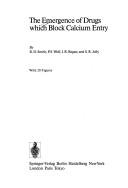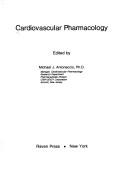| Listing 1 - 3 of 3 |
Sort by
|

ISBN: 3540186204 Year: 1988 Publisher: Berlin : Springer,
Abstract | Keywords | Export | Availability | Bookmark
 Loading...
Loading...Choose an application
- Reference Manager
- EndNote
- RefWorks (Direct export to RefWorks)

ISBN: 089004063X 9780890040638 Year: 1977 Publisher: New York (N.Y.): Raven Press,
Abstract | Keywords | Export | Availability | Bookmark
 Loading...
Loading...Choose an application
- Reference Manager
- EndNote
- RefWorks (Direct export to RefWorks)
Pharmacology. Therapy --- Pathology of the circulatory system --- Cardiovascular Diseases --- Cardiovascular System --- Cardiovascular agents --- Cardiovascular system --- Agents cardiovasculaires --- Appareil cardiovasculaire --- drug therapy --- drug effects --- Diseases --- Chemotherapy --- Maladies --- Chimiothérapie --- Cardiovascular pharmacology --- Pharmacology --- drug therapy. --- drug effects. --- Drug effects --- Effect of drugs on --- Cardiovascular pharmacology. --- Textbooks & monographs 1891-2000 --- Textbooks & monographs 1891-2000. --- Chimiothérapie --- Cardiovascular System - drug effects --- Cardiovascular Diseases - drug therapy
Book
ISBN: 1441930701 0387959610 9786612970689 1282970682 0387959629 Year: 2009 Publisher: Dordrecht ; London : Springer,
Abstract | Keywords | Export | Availability | Bookmark
 Loading...
Loading...Choose an application
- Reference Manager
- EndNote
- RefWorks (Direct export to RefWorks)
Animal Models in Cardiovascular Research covers both historical and recent advances in our understanding of the cardiovascular system from studies conducted in animal models. The last decade has seen an explosion in the use of very specialized congenic and transgenic animal models that were not described in the previous two editions. The results of many of these studies provide a sometime bewildering array of redundant, overlapping and competing molecular pathways demanding further study. This third edition is designed to provide a better basis for understanding and using animal models in the current climate of background knowledge and information. The first and second editions of Animal Models in Cardiovascular Research emphasized normal cardiovascular parameters and the cardiovascular effects of a wide variety of drugs commonly used for restraint, anesthesia and pain control in the various animal species. The third edition is focused on the avalanche of genetic, molecular and protein-based information generated from the use of both congenic and transgenic animal models. Updated and expanded chapters provide new information generated from classical, congenic and transgenic animal models used to study ischemic heart disease, cardiomyopathy, heart failure, hypertension and atherosclerotic disease. Completely new chapters in this third edition describe the techniques, problems and pitfalls associated with the measurement of cardiac and vascular function and ventricular/arterial coupling dynamics in various animal models. There is a new chapter detailing problems and pitfalls associated with isolated heart preparations and another describing animal models for the study of neurohumeral and CNS control of the cardiovascular system.
Cardiovascular diseases. --- Cardiovascular system -- Diseases -- Animal models. --- Cardiovascular system -- Drug effects. --- Cardiovascular system -- Research -- Methodology. --- Disease models, Animal. --- Cardiovascular system --- Disease Models, Animal --- Cardiovascular Diseases --- Cardiovascular System --- Research --- Science --- Diseases --- Animal Diseases --- Anatomy --- Models, Animal --- Models, Biological --- Natural Science Disciplines --- Investigative Techniques --- Models, Theoretical --- Analytical, Diagnostic and Therapeutic Techniques and Equipment --- Disciplines and Occupations --- Physiology --- Human Anatomy & Physiology --- Medicine --- Health & Biological Sciences --- Animal models --- Methodology --- Animal models. --- Methodology. --- Circulatory system --- Vascular system --- Life sciences. --- Cardiology. --- Animal physiology. --- Life Sciences. --- Animal Physiology. --- Biomedicine general. --- Blood --- Circulation --- Medicine. --- Clinical sciences --- Medical profession --- Human biology --- Life sciences --- Medical sciences --- Pathology --- Physicians --- Heart --- Internal medicine --- Animal physiology --- Animals --- Biology --- Health Workforce --- Biomedicine, general.
| Listing 1 - 3 of 3 |
Sort by
|

 Search
Search Feedback
Feedback About UniCat
About UniCat  Help
Help News
News